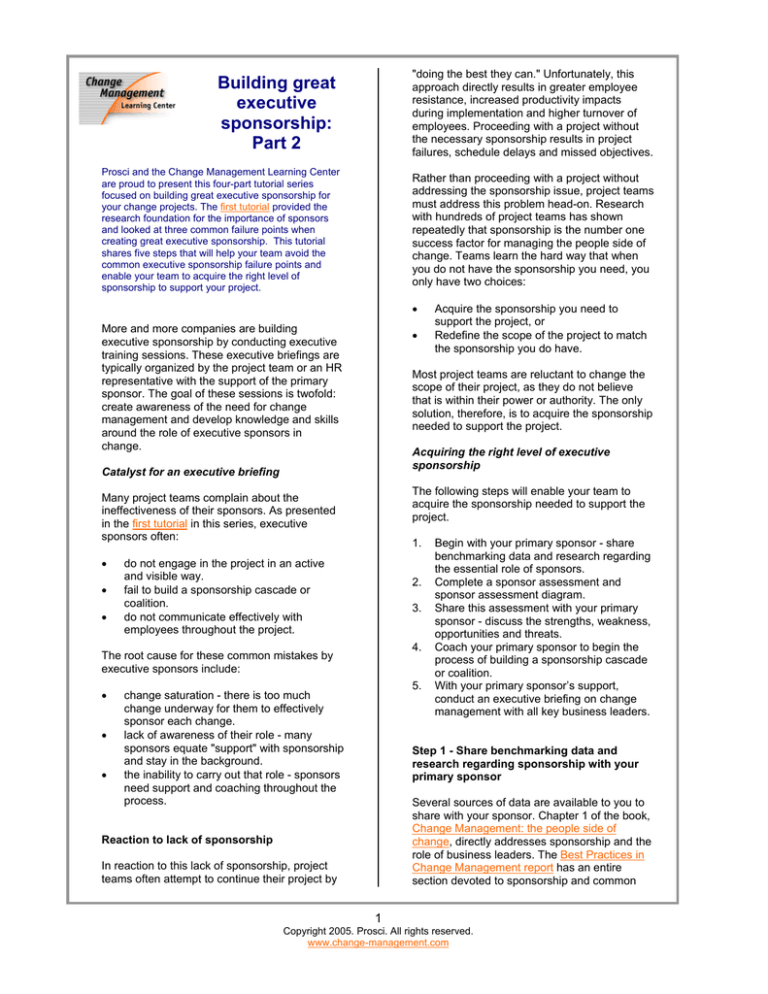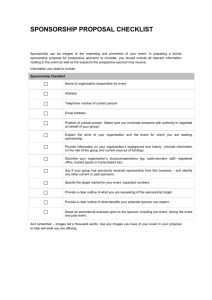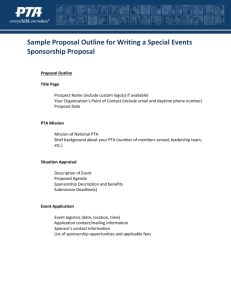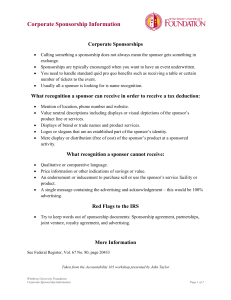
"doing the best they can." Unfortunately, this
approach directly results in greater employee
resistance, increased productivity impacts
during implementation and higher turnover of
employees. Proceeding with a project without
the necessary sponsorship results in project
failures, schedule delays and missed objectives.
Building great
executive
sponsorship:
Part 2
Prosci and the Change Management Learning Center
are proud to present this four-part tutorial series
focused on building great executive sponsorship for
your change projects. The first tutorial provided the
research foundation for the importance of sponsors
and looked at three common failure points when
creating great executive sponsorship. This tutorial
shares five steps that will help your team avoid the
common executive sponsorship failure points and
enable your team to acquire the right level of
sponsorship to support your project.
Rather than proceeding with a project without
addressing the sponsorship issue, project teams
must address this problem head-on. Research
with hundreds of project teams has shown
repeatedly that sponsorship is the number one
success factor for managing the people side of
change. Teams learn the hard way that when
you do not have the sponsorship you need, you
only have two choices:
•
More and more companies are building
executive sponsorship by conducting executive
training sessions. These executive briefings are
typically organized by the project team or an HR
representative with the support of the primary
sponsor. The goal of these sessions is twofold:
create awareness of the need for change
management and develop knowledge and skills
around the role of executive sponsors in
change.
•
Most project teams are reluctant to change the
scope of their project, as they do not believe
that is within their power or authority. The only
solution, therefore, is to acquire the sponsorship
needed to support the project.
Acquiring the right level of executive
sponsorship
Catalyst for an executive briefing
The following steps will enable your team to
acquire the sponsorship needed to support the
project.
Many project teams complain about the
ineffectiveness of their sponsors. As presented
in the first tutorial in this series, executive
sponsors often:
•
•
•
1.
do not engage in the project in an active
and visible way.
fail to build a sponsorship cascade or
coalition.
do not communicate effectively with
employees throughout the project.
2.
3.
4.
The root cause for these common mistakes by
executive sponsors include:
•
•
•
Acquire the sponsorship you need to
support the project, or
Redefine the scope of the project to match
the sponsorship you do have.
5.
change saturation - there is too much
change underway for them to effectively
sponsor each change.
lack of awareness of their role - many
sponsors equate "support" with sponsorship
and stay in the background.
the inability to carry out that role - sponsors
need support and coaching throughout the
process.
Begin with your primary sponsor - share
benchmarking data and research regarding
the essential role of sponsors.
Complete a sponsor assessment and
sponsor assessment diagram.
Share this assessment with your primary
sponsor - discuss the strengths, weakness,
opportunities and threats.
Coach your primary sponsor to begin the
process of building a sponsorship cascade
or coalition.
With your primary sponsor’s support,
conduct an executive briefing on change
management with all key business leaders.
Step 1 - Share benchmarking data and
research regarding sponsorship with your
primary sponsor
Several sources of data are available to you to
share with your sponsor. Chapter 1 of the book,
Change Management: the people side of
change, directly addresses sponsorship and the
role of business leaders. The Best Practices in
Change Management report has an entire
section devoted to sponsorship and common
Reaction to lack of sponsorship
In reaction to this lack of sponsorship, project
teams often attempt to continue their project by
1
Copyright 2005. Prosci. All rights reserved.
www.change-management.com
sponsor mistakes, with input from hundreds of
companies. The purpose of this step is to build
awareness and desire with your primary
sponsor to 1) engage as a sponsor of change
on your project and 2) begin the process of
building a sponsorship cascade.
take with individuals one-on-one and collectively
with groups of managers. Discuss potential
opportunities to begin working with managers at
staff meetings, monthly or quarterly meetings,
conferences or other gatherings of business
leaders.
Step 2 - Complete a sponsor assessment
Step 4 - Coach your sponsor
A simple way to complete a sponsor
assessment is to draw an "organization chart"
view of all the key managers and business
leaders that are needed to support your project.
You then shade each box red, yellow or green
depending on two considerations. First, what is
the position of each manager on this change
(supporting, opposed or neutral)? Second, what
is their competency and willingness to act as
sponsors of change?
You must view your efforts to build sponsorship
as a process and not a single act. Once you
have your sponsor's attention, schedule regular
meetings to address progress with building your
sponsor cascade or coalition. Provide your
sponsor with tools and suggestions for working
with managers. Provide samples of sponsor
roles and illustrate how each manager will be at
different points as sponsors of change.
Step 5 - Schedule an executive briefing
Managers who are supportive of the change and
are willing and able to sponsor the change are
shaded green on your diagram. Managers who
are supportive of the change, but not willing or
able to sponsor the change are shaded yellow.
Managers who are opposed to the change are
shaded red. Special attention should be paid to
managers who are both opposed to the change
and who are competent change sponsors.
These individuals know how to work directly
against the change and are a threat to the
project. Sponsor assessment tools to help
determine a manager's competency can be
found in the Change Management Toolkit and
new Change Management Pilot Professional, as
well as detailed explanations and examples.
You should have sufficient awareness and
desire at this point with your primary sponsor to
schedule an executive training session or
executive briefing on change management. Find
a good time when these business leaders are
together for another reason, and ask for the
agenda to include a 2-4 hour executive briefing
on change management. Invite a guest speaker
to share why change management is critical for
business success and the key role of sponsors
during the change process. If possible, integrate
discussions about a current change with this
executive briefing. Make it conversational and
engaging.
As time passes, your sponsor assessment
diagram should be updated and should
gradually shift color from red/yellow to
yellow/green. Using this tool to track progress
keeps the focus on a key success factor for your
project: sponsorship.
Example sponsor assessment
Summary
Step 3 - Share this assessment with your
primary sponsor
As a project team, your efforts in building
executive sponsorship are as important as any
other task you will complete. Projects teams
around the world report that the one thing they
would do differently on their next project is to
ensure that they had the necessary sponsorship
for their project. If your project is underway,
don't wait. Effective sponsorship will result in
your project meeting objectives and staying on
schedule.
Using this tool, meet with your primary sponsor.
This diagram is often a wake-up call for senior
business leaders that often assume that
everyone is on board or that the message would
"trickle down" and the support would be there
when needed. Discuss the strengths,
weaknesses, opportunities and threats
presented by this diagram. Using this diagram,
identify steps that your primary sponsor can
2
Copyright 2005. Prosci. All rights reserved.
www.change-management.com
Resource guide
Benchmarking Reports and Toolkits
Books and Resources to distribute
Best Practices in Change Management:
288 companies share experiences in managing
change and lesson on how to build great
executive sponsorship. Includes success
factors, methodology, role of top management,
communications, team structure and more. The
report makes it easy to learn change
management best practices and discover the
mistakes to avoid when creating executive
sponsorship.
Change Management: the people side of
change: a solid foundation in change
management perspectives, theories, activities
and practices.
Employee's Survival Guide to Change:
answers questions most employees are
unwilling to ask and uncovers what it takes to
survive and thrive in today’s changing
workplace. Employees will learn the ADKAR
model and become effective change agents,
instead of difficult change barriers.
Change Management Toolkit:
a comprehensive change management process,
including templates, worksheets, assessments,
checklists and guidelines - a must have for
change management team members and
consultants.
Executive team training
Prosci provides customized executive training.
Please call 970-203-9332 for more details.
Change Management Guide for Managers
and Supervisors: a guide specifically designed
for managers and supervisors dealing with
change - complete with team and individual
coaching activities, best practices findings and
frequently asked questions.
Online tools
Change Management Pilot: a fully electronic
version of Prosci's popular change management
toolkit with templates, worksheets,
assessments, checklists, eLearning modules,
ready-to-use presentations and guidelines.
Change Management Pilot Professional:
a fully electronic version that combines the
Change Management Pilot with the Change
Management Guide for Managers and
Supervisors and Employee’s Survival Guide - a
combination that allows you to reach each level
of the organization.
3
Copyright 2005. Prosci. All rights reserved.
www.change-management.com




